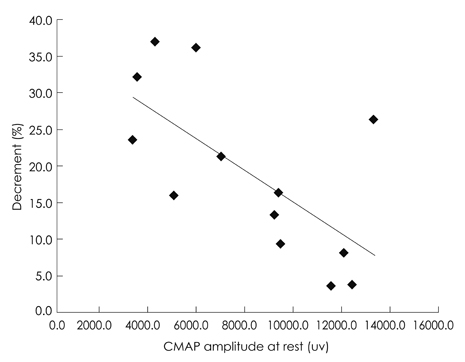J Clin Neurol.
2013 Jan;9(1):32-35. 10.3988/jcn.2013.9.1.32.
Decremental Responses to Repetitive Nerve Stimulation in X-Linked Bulbospinal Muscular Atrophy
- Affiliations
-
- 1Department of Neurology, Kwandong University College of Medicine, Myongji Hospital, Goyang, Korea.
- 2Department of Neurology, Ewha Womans University School of Medicine, Seoul, Korea.
- 3Department of Neurology, Yonsei University School of Medicine, Seoul, Korea.
- 4Sunwoo & Cho Neurology Clinic, Seoul, Korea. sunwooin@yuhs.ac
- KMID: 2287568
- DOI: http://doi.org/10.3988/jcn.2013.9.1.32
Abstract
- BACKGROUND AND PURPOSE
X-linked bulbospinal muscular atrophy (X-BSMA) is characterized by bulbar and spinal muscular weakness and fasciculations. Although X-BSMA is a motor neuronopathy, there are several reports of myasthenic symptoms or decremental responses to repetitive nerve stimulation (RNS). We report the results of applying the RNS test to 15 patients among 41 with genetically confirmed X-BSMA; these 15 patients complained of fatigue, ease of becoming tired, or early muscular exhaustion.
METHODS
The 3-Hz RNS test was performed on the trapezius, nasalis, orbicularis oculi, flexor carpi ulnaris, and abductor digiti quinti muscles. A decrement greater than 10% was considered abnormal. Additionally, a pharmacologic response to neostigmine was identified in three patients.
RESULTS
A significant decrement was observed in 67% of patients, and was most common in the trapezius muscle (nine cases). The decrement of the trapezius muscle response ranged from 15.9% to 36.9%. The decrement was inversely correlated with the amplitude of compound muscle action potentials at rest. Neostigmine injection markedly improved the decrement in three patients, who showed noticeable decremental responses to 3-Hz RNS.
CONCLUSIONS
This study shows that myasthenic symptoms and abnormal decremental responses to low-rate RNS are common in X-BSMA.
Keyword
MeSH Terms
Figure
Cited by 2 articles
-
Clinical and Electrophysiologic Responses to Acetylcholinesterase Inhibitors in MuSK-Antibody-Positive Myasthenia Gravis: Evidence for Cholinergic Neuromuscular Hyperactivity
Ha Young Shin, Hyung Jun Park, Hyo Eun Lee, Young-Chul Choi, Seung Min Kim
J Clin Neurol. 2014;10(2):119-124. doi: 10.3988/jcn.2014.10.2.119.Clinical Significance of Repetitive Compound Muscle Action Potentials in Patients with Myasthenia Gravis: A Predictor for Cholinergic Side Effects of Acetylcholinesterase Inhibitors
Hyo Eun Lee, Yool-hee Kim, Seung Min Kim, Ha Young Shin
J Clin Neurol. 2016;12(4):482-488. doi: 10.3988/jcn.2016.12.4.482.
Reference
-
1. Kim JY, Park KD, Kim SM, Sunwoo IN. Repetitive nerve stimulation test in amyotrophic lateral sclerosis with predominant oropharyngeal manifestations. J Clin Neurol. 2011. 7:31–33.
Article2. Denys EH, Norris FH Jr. Amyotrophic lateral sclerosis. Impairment of neuromuscular transmission. Arch Neurol. 1979. 36:202–205.3. Bernstein LP, Antel JP. Motor neuron disease: decremental responses to repetitive nerve stimulation. Neurology. 1981. 31:204–207.
Article4. Wang FC, De Pasqua V, Gérard P, Delwaide PJ. Prognostic value of decremental responses to repetitive nerve stimulation in ALS patients. Neurology. 2001. 57:897–899.
Article5. Killian JM, Wilfong AA, Burnett L, Appel SH, Boland D. Decremental motor responses to repetitive nerve stimulation in ALS. Muscle Nerve. 1994. 17:747–754.
Article6. Yamada M, Inaba A, Shiojiri T. X-linked spinal and bulbar muscular atrophy with myasthenic symptoms. J Neurol Sci. 1997. 146:183–185.
Article7. Ertekin C, Sirin H. X-linked bulbospinal muscular atrophy (Kennedy's syndrome): a report of three cases. Acta Neurol Scand. 1993. 87:56–61.
Article8. Boz C, Kalay E, Sahin N, Velioglu S, Ozmenoglu M, Karagüzel A. Ocular myasthenia gravis associated with x-linked recessive spinal and bulbar muscular atrophy. J Clin Neuromuscul Dis. 2004. 5:115–118.
Article9. Lee BJ, Kwon KH, Kim SM, Na HR, Lee BC, Ryu SH, et al. A case of Kennedy syndrome mimicking myasthenia gravis. J Korean Neurol Assoc. 2001. 19:544–546.10. Meriggioli MN, Rowin J. Fatigue and abnormal neuromuscular transmission in Kennedy's disease. Muscle Nerve. 2003. 27:249–251.
Article11. Inoue K, Hemmi S, Miyaishi M, Kutoku Y, Murakami T, Kurokawa K, et al. Muscular fatigue and decremental response to repetitive nerve stimulation in X-linked spinobulbar muscular atrophy. Eur J Neurol. 2009. 16:76–80.
Article12. Oh SJ. Oh SJ, editor. Repetitive nerve stimulation test. Principles of Clinical Electromyography: Case Studies. 1998. Baltimore: Williams & Wilkins;59–75.13. AAEM Quality Assurance Committee. Literature review of the usefulness of repetitive nerve stimulation and single fiber EMG in the electrodiagnostic evaluation of patients with suspected myasthenia gravis or Lambert-Eaton myasthenic syndrome. Muscle Nerve. 2001. 24:1239–1247.14. Doyu M, Sobue G, Kimata K, Yamamoto K, Mitsuma T. Androgen receptor mRNA with increased size of tandem CAG repeat is widely expressed in the neural and nonneural tissues of X-linked recessive bulbospinal neuronopathy. J Neurol Sci. 1994. 127:43–47.
Article15. Sorarù G, D'Ascenzo C, Polo A, Palmieri A, Baggio L, Vergani L, et al. Spinal and bulbar muscular atrophy: skeletal muscle pathology in male patients and heterozygous females. J Neurol Sci. 2008. 264:100–105.
Article16. Monks DA, O'Bryant EL, Jordan CL. Androgen receptor immunoreactivity in skeletal muscle: enrichment at the neuromuscular junction. J Comp Neurol. 2004. 473:59–72.
Article
- Full Text Links
- Actions
-
Cited
- CITED
-
- Close
- Share
- Similar articles
-
- Quantitative Change of Repetitive Nerve StimulationTest in Myasthenia Gravis
- Familial congenital myopathy with prominent decremental responses in repetitive nerve stimulation testing
- A Case of Kennedy Syndrome Mimicking Myasthenia Gravis
- Findings of repetitive nerve stimulation test in myasthenia gravis: A case-control study
- Repetitive Nerve Stimulation Test in Myotonic Patients



